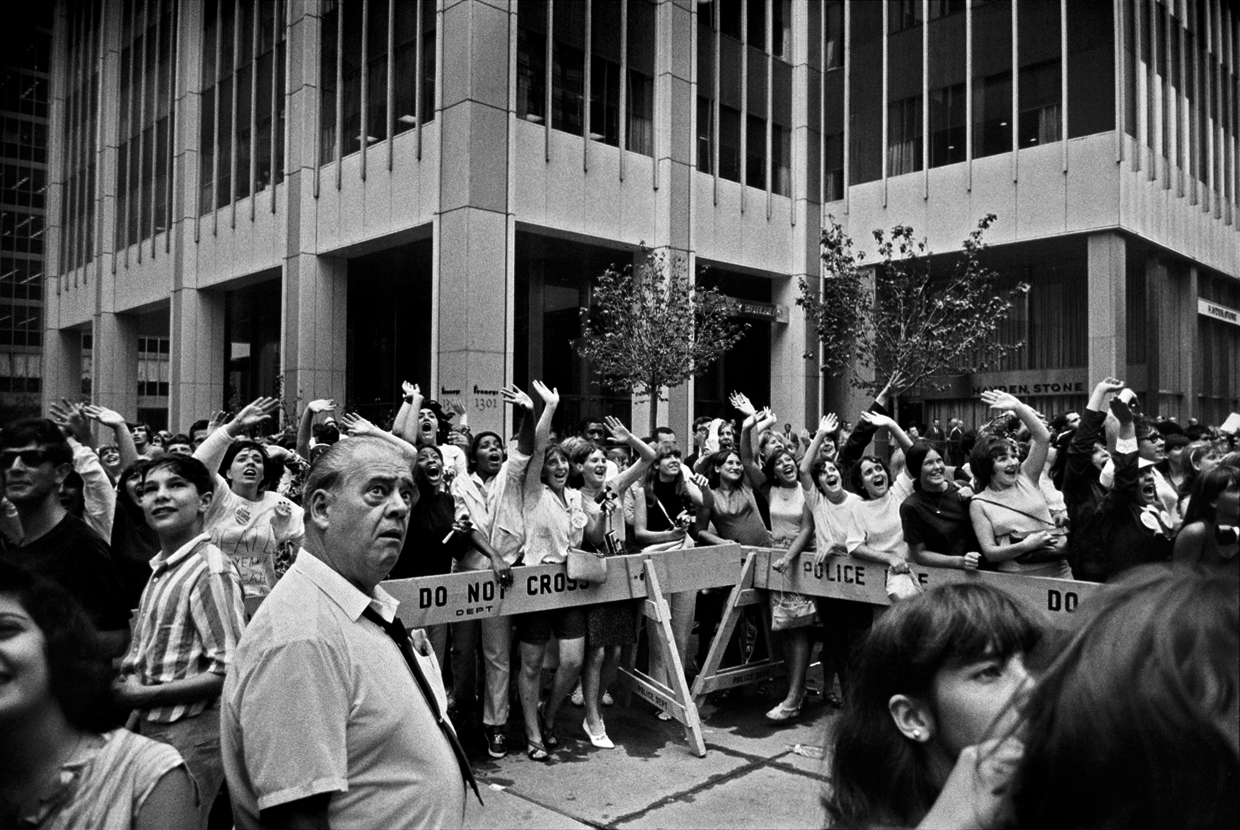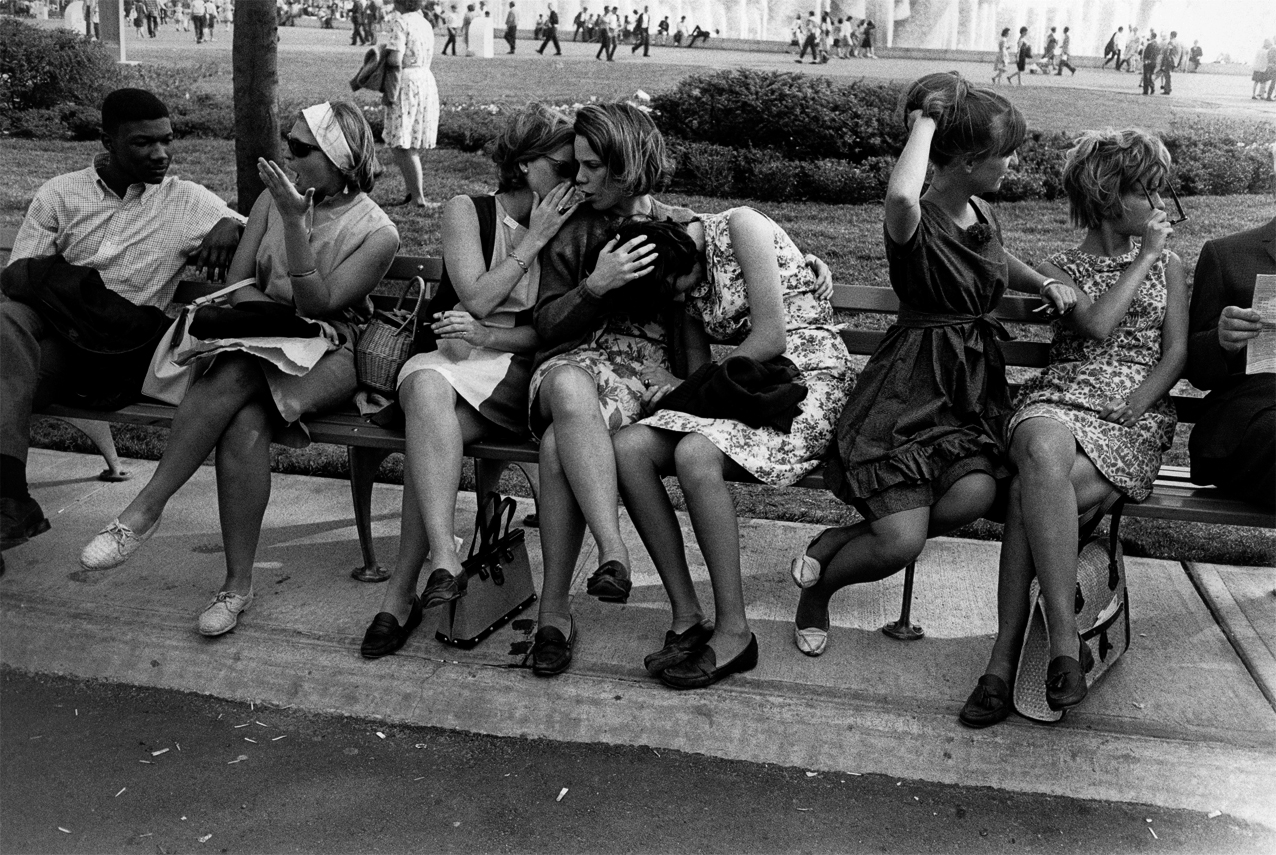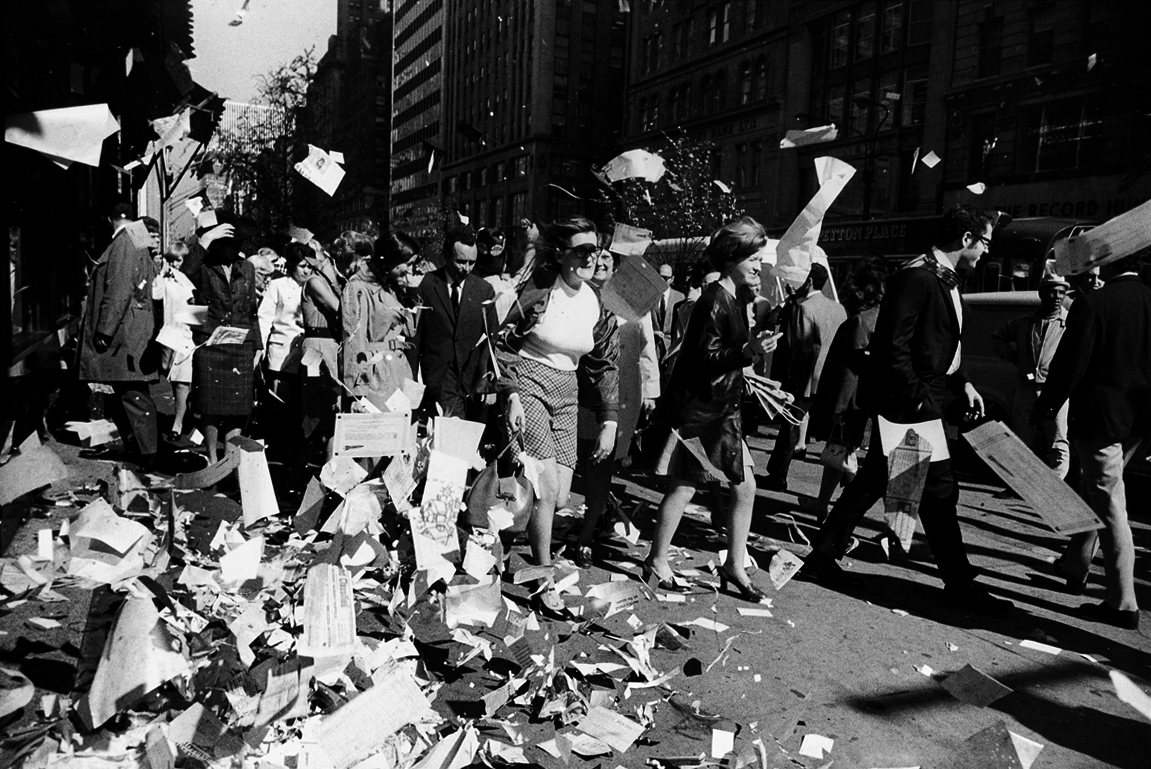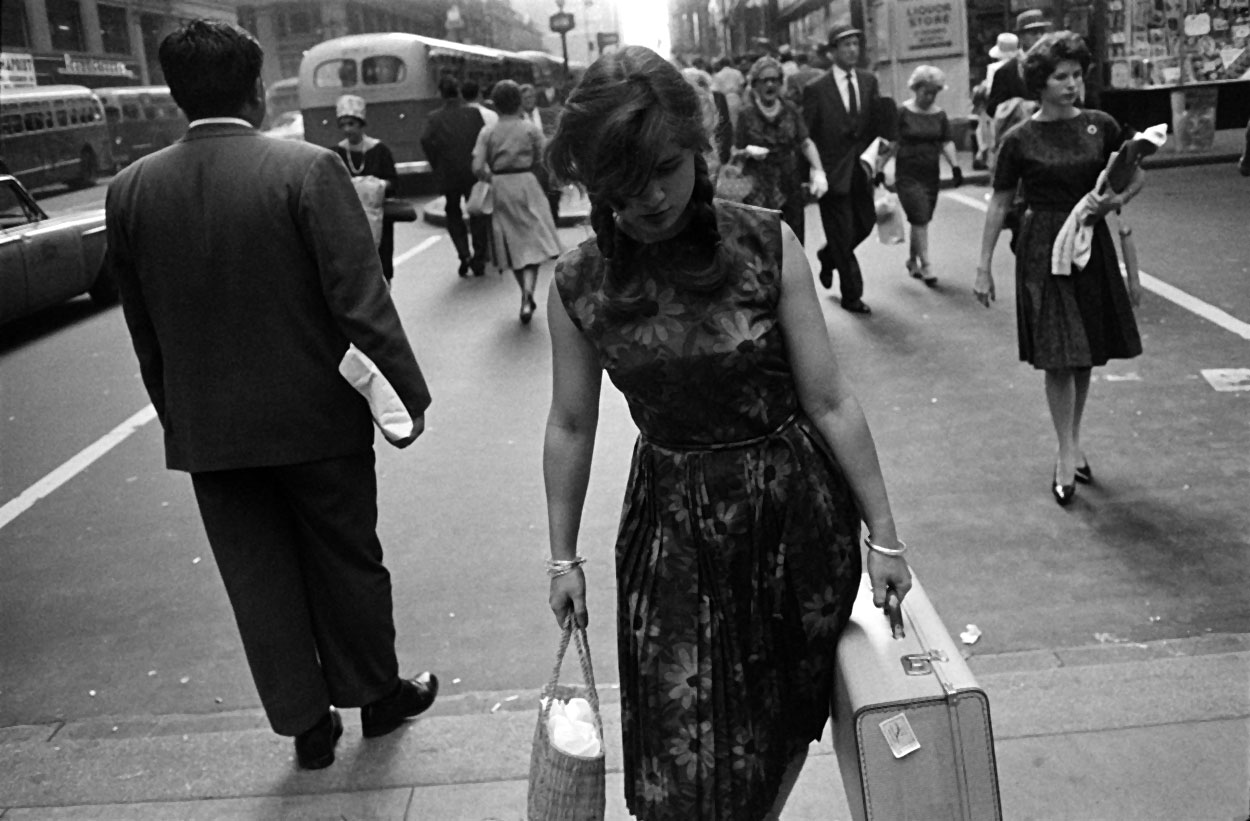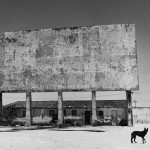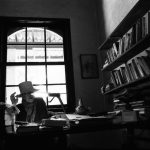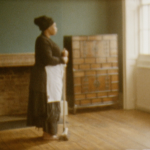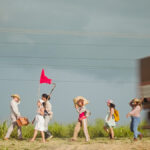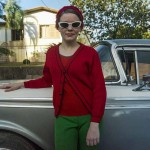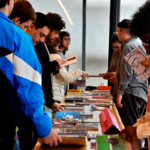High Voltage
Publicado em: 19 de September de 2013The pulse of the streets and postwar America in GARRY WINOGRAND’s teeming images
When future historians try to retrieve the flavor and feel of the American sixties, an era that already seems legendary and remote, they will find no better resource than the photographs of Garry Winogrand. Other photographers supplied a fuller record of the war demonstrations (anti- and pro-), political conventions, assassinations, hippie love-ins and moon launches. For a chronicler of the sixties, these are the elephants in the room, and Winogrand took them in, but he did so like the blind men in the fable, grasping hold of the tail, ears or trunk. Focusing on the margins, not the main event, he shored up fragments without seeking synthesis.Looking at some of his best work, you might imagine that he is playing a game, or engaging in a contest, to see just how many discordant elements can be packed into a harmonious photograph. But to judge from Winogrand’s gnomic comments, he saw himself as a reporter, not a formalist. “You could say that I’m a student of photography – and I am – but really I’m a student of America,” he once said. Discontinuity for him was the story. In his version of the American experience, the gaps separating people mattered more than the ties that bound them. Americans were like riders in a bus or elevator (he photographed both), people who were packed into close proximity yet enclosed in invisible cauls of isolation. They were – to appropriate the title of David Riesman’s tremendously popular sociological study – the lonely crowd.
To understand the sensibility that pervades Winogrand’s pictures, it is useful to compare him to two great predecessors in street photography, Henri Cartier-Bresson and Robert Frank. The photographs of Cartier- Bresson capture lyrical instants, those dreamlike juxtapositions in which everything coheres into a magical whole. Even the lowest subjects – dogs mating on the street, a man jumping a puddle behind a gritty railroad station – are transformed into flashes of beauty, epiphanies that a religious person would call moments of grace. The scattered shards of experience have been assembled into something unified, and the beauty is heightened by the contrast between the fixity of the photograph and the evanescence of the subject. Cartier-Bresson memorialized what is fleeting. Frank’s photographs, by comparison, evoke stillness. His subjects are more static, in the manner of Walker Evans, who was one of his early supporters. Even in those instances when he shot, say, a moving crowd or a couple rushing down the street, the people feel frozen. But that becalmed quality is not the most distinctive characteristic of Frank. In his pictures, especially in his breakthrough book, The Americans, Frank demonstrated that documentary photography might be as individually expressive as poetry. You could talk about Frank’s America as you would about Walt Whitman’s. This was something new. Although the stock emotions of sentimentality and righteous anger were common adulterants of documentary photography, Frank’s alienated engagement (or intense detachment) was very personal, and for that reason, revolutionary. In some of Frank’s photographs, a scene is being seen through a scrim – a transparent flag, a screen door, gauzy curtains – as if to emphasize the self-conscious photographer’s awareness that his images are filtered through his sensibility.
Like Cartier-Bresson, Winogrand tended to snap his subjects as they moved and shifted rapidly before him. He took some pictures with a Bressonian balance: two of the best are New York World’s Fair (1964), in which three groups of people on a park bench gesticulate with the movements of a Hellenistic frieze; and Statue of Liberty Ferry, New York (ca. 1968), in which sightseers are distributed on an art moderne boat with wedding-cake regularity. But this work doesn’t lie at his heart. He didn’t share the Frenchman’s love of order, the urge to discern classical constellations in a brimming sky. This difference in sensibility may have been a product of their origins. Cartier-Bresson was the scion of a wealthy French manufacturing family. Hierarchical gradations and rules of decorum were part of his birthright. Winogrand, like the Swiss immigrant Frank, was a Jewish outsider. He reveled in disorder. Raised in a working-class home in the Bronx, where his father was a garment-industry leather cutter, Winogrand dropped out of the painting program at Columbia College to take up the trade of photography, after discovering through a friend the alchemy of the darkroom. In a practical sense, that decision meant working for magazines, as he did at first, or advertising clients, for which he toiled later. In 1950, when he ventured into photography, Winogrand, 22, was three years out of the army. A photograph he made that year, of a handsome young sailor walking with a weekend bag beneath a hortatory allee of New York City street lamps, is unabashedly romantic. It is a Cindy Sherman “film still” without the irony. Both Winogrand and the country were feeling optimistic. A decade later he photographed a pretty young woman encumbered with two bags on a New York street, alone in the human flux, her eyes downcast, her mouth determined, her prospects uncertain. These two photographs might serve as frontispieces to their respective decades.
Around 1960, while still earning an unsteady income from magazines and ad agencies, Winogrand greatly increased his output of noncommissioned photographs. He had landed on his subject. His bristling temperament and populist upbringing conditioned him to the demotic energy of the New York streets, and he had a take on America that was as distinctive as Frank’s. Although he revered Frank, to the point of avoiding him personally out of awed respect, he was more directly influenced by his friend and mentor Dan Weiner, a colleague who, before dying young in a plane crash, explored the absurd aspects of American life with a wit comparable to Winogrand’s. There were other gifted photographers prowling the streets of Manhattan: Winogrand’s lifelong friend Lee Friedlander, for one, and Joel Meyerowitz, who later became a close associate, for another. But Winogrand’s take on the scene was unique. He understood intuitively – perhaps from a familiarity with family conversations in which each member spoke without listening – that a big city superimposed individual lives on a common canvas, much in the way a Pollock painting combined skeins of paint, one poured over another. Every life had its own pattern, and the layering of these patterns formed another, more complicated pattern. To contain the pulsating cacophony of urban life within a coherent whole was one of Winogrand’s goals. He had ways of imposing formal coherence on scenes of random activity: stripes and plaids of raking light; strong diagonals (he could use flagsticks the way Paolo Uccello did lances); exaggerated perspectives through the use of a wide-angle lens; and the repetitive continuities of pillars, window mullions, tree lines, cinderblock walls, and chain link fences. It was a jazz pianist’s trick: if the left hand is clocking a regular rhythm, the right hand can go crazy.
A photographer’s tactics for depicting modern life are not so different from a painter’s. There is a wonderful Winogrand photograph, taken before 1960 at the corner of 42nd Street and Fifth Avenue, that uses many of the same compositional strategies as Gustave Caillebotte’s 1877 masterpiece, Paris Street, Rainy Day. Portraying the unrelated activity of strangers who share a public space, both artists rely on strong elements to hold the image together: two large protagonists on the right (to which the painter has added the partially cropped back of a third), an emphatic vertical light pole just off the central axis, a curb that demarcates the two terrains of sidewalk and street, long stretches of building facades that flank both sides of the scene, and an extended perspective in which distant pedestrians move at their own paces at different depths of the field. Both artists emphasize the empty space that separates people. But how different these pictures feel! Caillebotte, whose haut bourgeois background resembled Cartier-Bresson’s, places his affluent strollers – the dual protagonists are a beautifully dressed man and woman sharing an umbrella – on a stage of Haussmann’s Paris, performing a ballet that is no less civilized for being unscripted. In Winogrand’s foreground, a head-scarfed old woman is snarling at the photographer, while another woman near her, lost in troubled thought, her hands clasped and her lips pressed, is looking downward. Notwithstanding the classical front of the New York Public Library, it’s an urban jungle.
People often are glancing in different directions in Winogrand photographs, even when they are speaking to each other. Their gaze is avoidant: an old woman lies injured on the ground but no one pays attention; a girl is eyeing the camera rather than a boy who is ardently kissing her. On a city street, as at a three-ring circus, you don’t know where to look or not look. In scenes with an object of a crowd’s attention (a space launch, a Beatles visit, or some other cynosure that Winogrand typically excluded from his frame), you can expect one person, a stand-in for the photographer, to be facing somewhere else.
Winogrand didn’t need crowds to convey loneliness. Traveling outside New York, he found it waiting for him in the detached houses and open garages of suburbia. In a famous picture, Albuquerque (1957), a small child plays in front of a house that some developer plunked down in the middle of the desert. The photographer’s wide-angle lens expands the distances, so that the concrete driveway stretches out implacably, and the tricycle lying on it seems too far off for the child at the house door ever to recover. In the suburbs, a vehicle is the only way out, and that ironic subtext lingers in the arid air. And where can a car take you, anyway? That is the question posed by another Winogrand photograph, Los Angeles (1964), in which a smartly dressed young woman stands in her garage alongside her handsome automobile, beneath the eaves of a cheaply built house in a subdivision, on the wide sea of concrete that constitutes her driveway.
All of this may give the impression that Winogrand’s photographs are uniformly grim, when in fact, bleak as they may be, they are often very funny. It is a particular kind of humor, mordant and Jewish. Winogrand once told Tod Papageorge that all the best photographers were Jewish; even Atget surely was. And indeed (Atget aside), many of the great photographers were. But even within that cohort, Winogrand was unsurpassed at locating the serendipitous weirdness of urban life, the Kafkaesque surprises. Perhaps his most unsettlingly comical picture is Central Park Zoo, New York (1967). A black man and a blonde woman, both of them young, attractive and well dressed, carry two chimpanzees, lovingly clothed, nestled in their arms. What makes the picture so unforgettable is the couple’s expression of earnestness and fortitude, as if they are living out a nightmare with the forbearance of Gregor Samsa. It is because they look like concerned parents, coping gracefully with the surprise fate has delivered to them, that the racial and political overtones of the photograph strike us so powerfully.
What was really happening in this picture? There is a prosaic explanation; but when someone proffered it to Winogrand’s most influential supporter, the curator John Szarkowski, he protested that he didn’t want to know, it would only weaken the impact of the photograph. Szarkowski believed, as the photographer Lisette Model once said, that a photograph is not a record of some external reality, but it is “living its own independent life and projecting, if we like it or not, its magic.” But there is a more particular reason for not delving too far into the derivation of Winogrand’s strange apparitions. They are fleeting encounters, the things you remark on a city street, which vanish before you can ask a question. Why is a monkey howling in the back of a convertible on Park Avenue? Why has a mother with two small children stopped in front of a blazing garbage can? In the pinball panoply of modern life, these puzzles bounce away as soon as they are posed. There is no time to pursue them. As if to underscore the rush of perception, Winogrand often took pictures at odd angles, so that the images appear to be glimpses caught from the corner of his eye. In place of Cartier-Bresson’s eternal epiphanies, he conjured up passing oddities.
Winogrand’s snapshot aesthetic (a phrase he hated) led some to dismiss his work as amateurish. It wasn’t merely obtuse critics who felt this way. Walker Evans, whose pictures Winogrand admired more than those of any other photographer, saw nothing of value in Winogrand’s art. Indeed, Evans didn’t view it as art. For him, the compositions were too helter-skelter, the subjects were too rude and raw. “Why do you want to photograph people like that?” he once asked a student. “They’re like all those people that man Winogrand photographs. They’re so vulgar!” Evans helped advance the careers of Lee Friedlander and Diane Arbus, the two other photographers whom Szarkowski included in the influential – indeed, now legendary – New Documents show in 1967 at the Museum of Modern Art. He did nothing for Winogrand. Even today, Winogrand’s lack of discipline and overwhelming volume of work continue to shadow his reputation, which is less secure than that of Arbus and Friedlander.
In 1984, at the age of 56, Winogrand died suddenly of cancer. His last years were difficult. Although he was working constantly until the end, virtually all of his known photographs predate his move away from New York in 1971. He relocated first to Chicago, then to Austin (he taught in universities in both cities) and finally to Los Angeles. As he aged, he shot more pictures than ever before, but he was no longer reliably making work prints, or by 1979 even contact sheets. Eventually, he stopped bothering to process his film. By the time he died, he had exposed over 20,000 rolls of film, or more than 700,000 images; 6,500 rolls of that film he had never seen. What treasures was he storing up?
Not many, it appears. In a major traveling retrospective of Winogrand’s career, organized by Leo Rubinfien for the San Francisco Museum of Modern Art, a selection of this late work is displayed for the first time. By and large, the late pictures lack the energy and originality of the earlier photographs. Much less activity occurs within the frame. And the humor, when it pokes up on rare occasion, is puerile and mean-spirited: a sheeplike fat boy is shown at the state fair with his prize sheep, for example. The charm of Winogrand’s best photographs is that he gives you the sense that he empathizes with the isolated people in them. In the later work, he is as detached from them as they are from the world at large.
The outstretched arm is a recurring gesture in Winogrand’s photographs – of people reaching without really connecting. In one evocative image from 1968, an affluent white hand is about to place a coin in the open palm of a black beggar. You don’t see the white man, just his fist, and you can sense that he is about to drop the coin without making physical contact with the object of his charity. The two men are divided by a chasm of race and class.
Wide as that gulf is, in the litany of Winogrand’s missed connections (and his yearning snapshots of the beautiful women he will never know should be included in this category), there are none as poignantly hopeless as those that separate people from animals. A bright-eyed, smiling porpoise watches a man cleaning its tank with a squeegee; a lady in dark glasses turns away from two rhinos that have turned away from her. Separated by glass or bars, the people and the animals can never touch. And yet, you believe, they would like to. There is seldom anything in the people’s faces, and less in the expressions of the animals, to convey this. Yet somehow, even more than in the atomized cities or the sprawling suburbs, it is in the company of animals that Winogrand’s people reveal the unbridgeable loneliness of the human condition.///
images: © Estate of Garry Winogrand, courtesy Fraenkel Gallery, San Francisco
Garry Winogrand (1928-1984) was born in New York and died in Tijuana, Mexico. One of the best known American photographers of the 1950s and 60s, he published the photo essays The Animals (1969), Women Are Beautiful (1975) and Public Relations (1977).
Arthur Lubow (1952) writes about cultural subjects for The New Yorker, Vanity Fair and the New York Times Magazine, amongst other publications. He is currently working on a biography of the photographer Diane Arbus.
///
Get to know ZUM’s issues | See other highlights from ZUM #4


